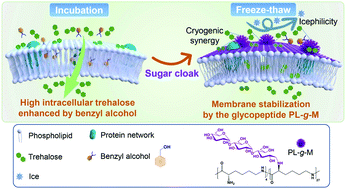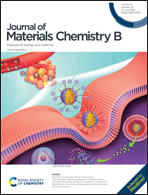Cryopreservation of human erythrocytes through high intracellular trehalose with membrane stabilization of maltotriose-grafted ε-poly(l-lysine)†
Abstract
Cryopreservation of human erythrocytes via suitable cryoprotectants is essential for transfusion during emergencies, but the conventional glycerolization method requires a tedious thawing–deglycerolization process. Alternatively, trehalose, a nonreducing disaccharide, has gained much attention as a biocompatible cryoprotectant due to its nature in living organisms capable of surviving extreme cold and desiccation. In this work, cryopreservation of human erythrocytes was realized through high intracellular trehalose enhanced by benzyl alcohol at 4 °C with membrane stabilization of maltotriose-grafted ε-poly(L-lysine). Intracellular trehalose could reach 94.2 ± 12.1 mM with slight impacts on morphology and cell functions, and the post-storage cryosurvival of human erythrocytes could achieve 96.2 ± 3.4% via membrane protection by the glycopeptide. It has been demonstrated that the functional glycopeptide performed as an extracellular cryoprotectant accompanied by high intracellular trehalose for synergistic cryopreservation of human erythrocytes in the biocompatible glycerol-free conditions. This two-step approach involving augmentation of intracellular trehalose at a hypothermic temperature and membrane stabilization of the functional glycopeptide could be an alternative way for human cell cryopreservation.



 Please wait while we load your content...
Please wait while we load your content...